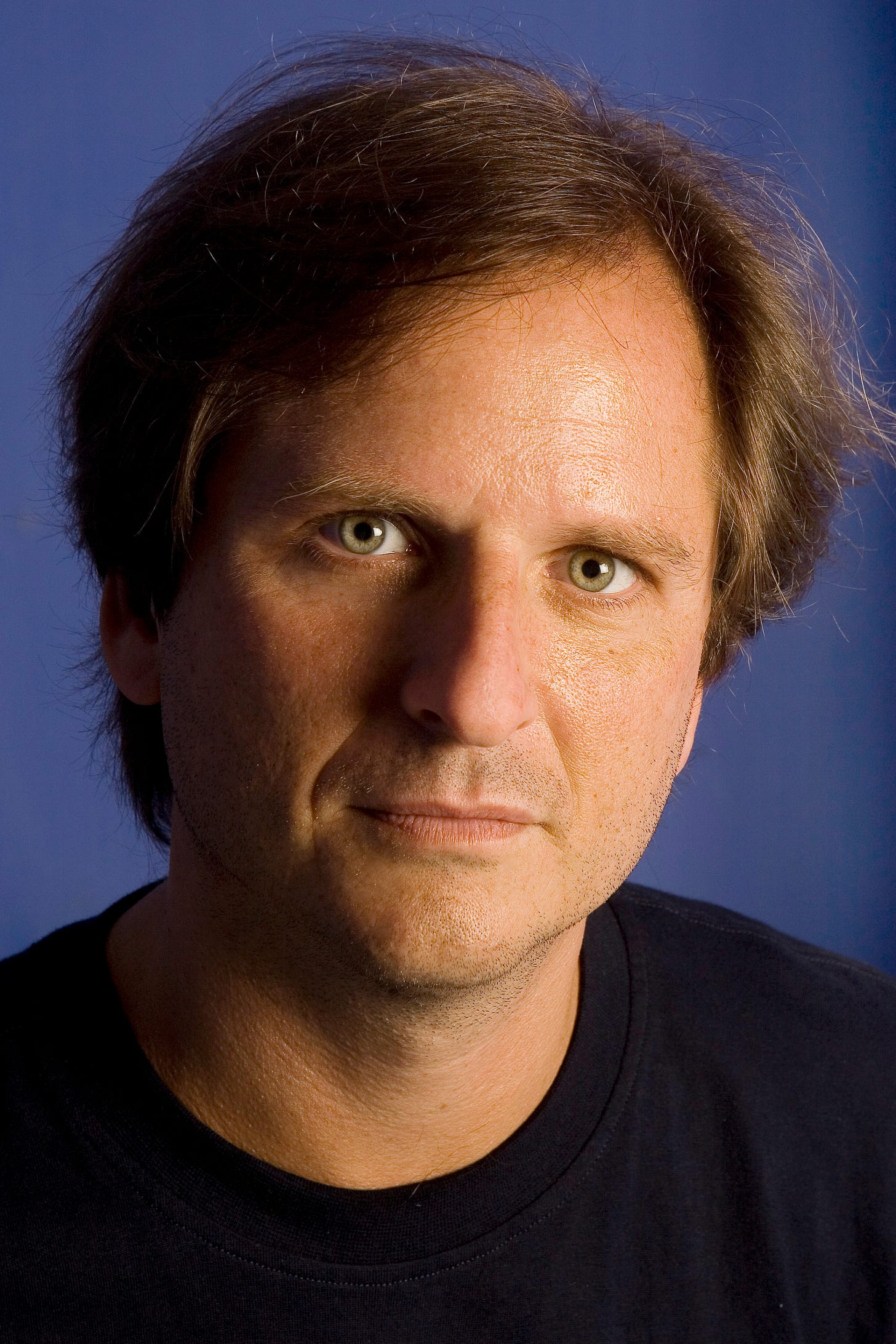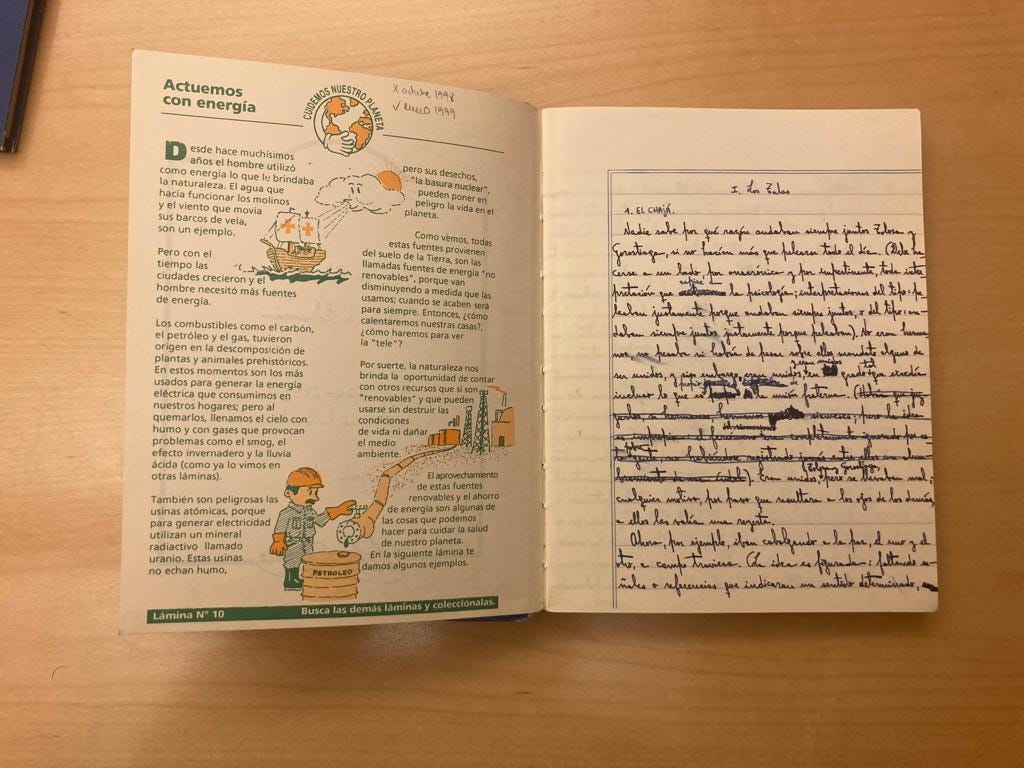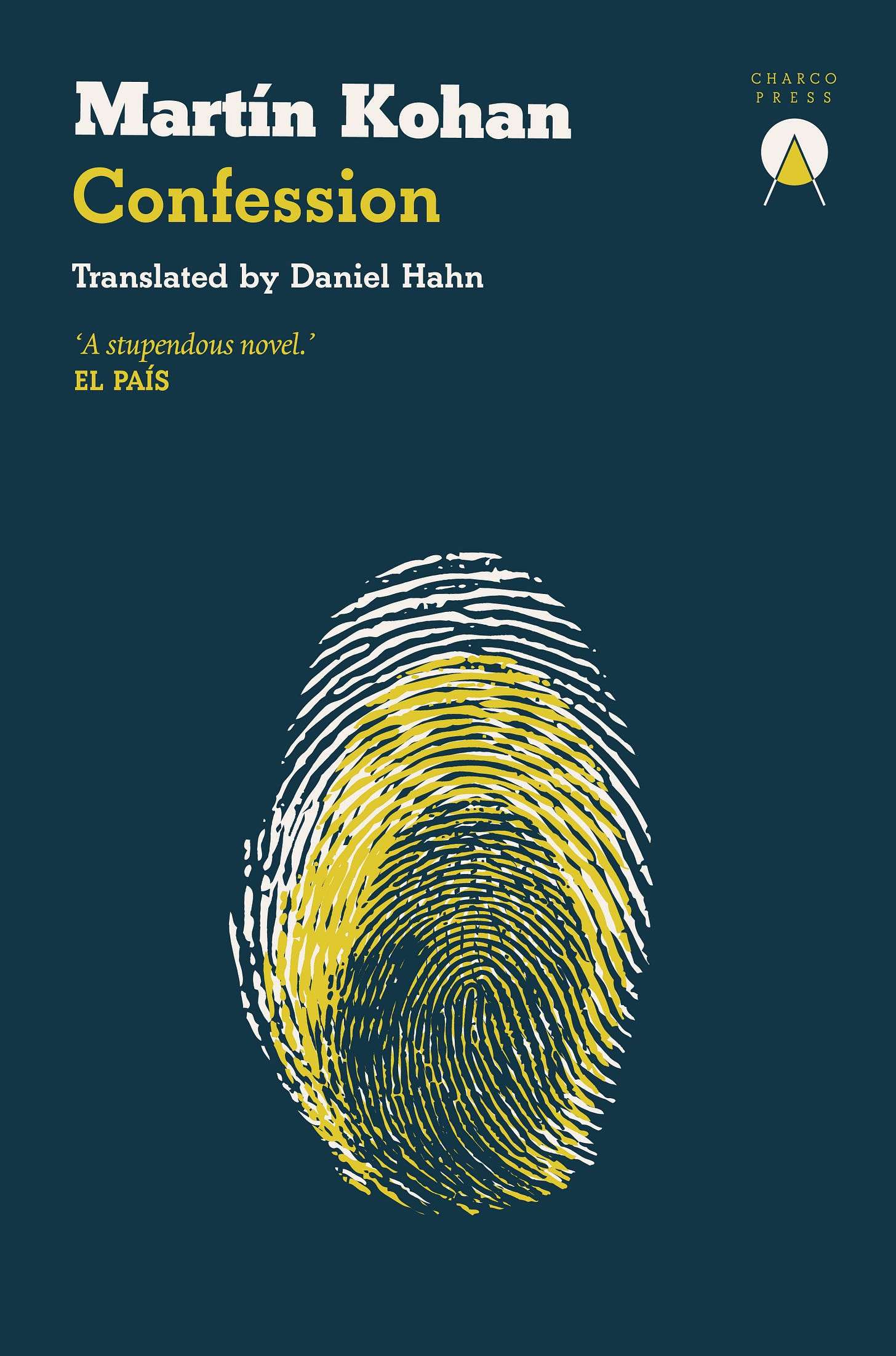The Last Bundist: Martín Kohan's CONFESSION
A piece that a publication was going to publish and decided not to.
This is a very occasional and extremely free Substack—I firmly believe writers belong in publications, but I’d rather post stuff here than let it mold in my computer. If you’d be interested in getting this via email you can sign up here.
Martín Kohan always arrives early; our interview was no exception. He wears only Adidas t-shirts; today, blue is the color of choice. Parking his bicycle in front of the café, Kohan made a phone call and crossed the street, perhaps for a last-minute errand. After our interview, he had to rush down the block to the storied Faculty of Philosophy of Philosophy and Letters of the University of Buenos Aires (UBA), where he himself studied and now teaches literary theory. He returned and sat down at the wrong table, not seeing me at first but waiting somewhat anxiously until I appeared. The alert, self-assured stride with which Kohan conducts himself belies what an unremarkable wardrobe and quiet, polite demeanor hide: he is one of Argentina’s leading writers and intellectuals.
Uninterested in feigning humility, Kohan’s confident intensity is thoughtful and unhesitant, his answers extensive but structured, as though pre-prepared. Unpretentious yet self-serious to a fault, clarity is Kohan’s priority when speaking: his voice has the trained cadence of an orator and an uncanny skill for emphasis. Three decades in the classroom, and stints as a journalist covering soccer and tennis, show. He fiddled with napkins and empty sugar packets while we spoke, especially when discussing his passions: literature, soccer, politics.
Since his first book, the 1993 novel La pérdida de Laura [Laura’s Loss], Kohan has authored some ten novels, four story collections, and written or co-written ten books of non-fiction. Though writers in Argentina have lost much of their preeminence in the media as magazines shuttered and books sections grow scarce, Kohan’s byline appears in major outlets with momentous frequency (more than 800 times, by his count). In 2007, Barcelona-based publisher Anagrama awarded him the Herralde prize, the most prestigious Spanish-language annual prize for a single work of literature, for his novel Ciencias morales (translated as School for Patriots in 2013). In September of last year, Charco Press published his latest novel, Confession, translated by Daniel Hahn.
Kohan’s most famous work, School for Patriots, focuses on María Teresa, a female warden at Buenos Aires’ storied Colegio Nacional, which Kohan himself attended. The year is 1982, and the reader knows that Argentina’s weakening military dictators will soon launch an attack into the British-held Falklands. María’s brother had been conscripted, since military service was mandatory at the time. As the novel progresses his increasingly succinct postcards arrive from further south, ever closer to islands that remain unmentioned. María, for her part, becomes convinced that some pupils are smoking in the men’s bathroom during class time and hides in the latrine stalls to catch them in fraganti. Her conservative, Catholic sense of moral duty devolves into a perverse sexual odyssey through which the contradictions of Argentine fascism come to light yet remain unspeakable, what one reviewer called “an abscess in language.”
The non-language of fascist brutality has guided much of Kohan’s work. A lifelong man of the left, he wrote a book on the German literary critic and theorist Walter Benjamin but is equally comfortable discussing his beloved team, Boca Juniors, and details with ease matches played decades earlier. I, however, wanted to understand the role of Judaism in his life, a part of his identity that has remained outside the scope of his public persona.
As he told me at the cafe, his only explicit thematization of Jewishness in fiction appears in a short story titled “La base de la fortuna” [The Foundation of Wealth] published in an early collection. Semenewicz, a diligent and thrifty man, pays for a private striptease from a woman called Katia. As the performance progresses, Katia offers ever-lower prices in exchange for various sex acts. Semenewicz refuses, having exhausted the last of that day’s allotted budget on the strip show itself, though he has a visible fold of bills in his pocket. The show finishes and he leaves, thinking “This is what I get for messing with whores.” Semenewicz’s parsimony frustrates Katia. After his departure, ignoring his name—which Kohan derived, like many of his characters, from a (non-Jewish) soccer player—and devoid of other indications, she utters the piece’s only mention of Judaism: “He just had to be a Jew.”
Kohan’s avoidance of autobiographical writing could explain Judaism’s absence from the work. Even his memoir Me acuerdo [I Remember] was, according to him, “written by withdrawing subjectivity” in the vein pioneered by Jewish French formal experimentalist Georges Perec. In I Remember, Kohan’s Jewish upbringing is evident: he attended a Jewish elementary school and refused to do his Bar Mitzvah, angering his practicing mother. He remained, he says, alienated from his Judaism, unable to see past the elements he rejected: religiosity, to which he has a marked aversion; Israel, which was simply never “in the plans” due to his family’s socio-economic status; and Jewish sociality, which felt “endogamic” and stifling.
Antisemitism, however, has always been a critical motivator of his identification with Judaism, even leading to arguments with an early, non-Jewish girlfriend. Kohan cited the influence of Jewish German philosopher Hannah Arendt, who suggested in The Origins of Totalitarianism that antisemitism was critical to the formation of modern Jewish identity.
He eventually found “positive,” affirmative elements of Judaism with which he could identify: his mentor at the University of Buenos Aires—renowned critic Josefina Ludmer—Hannah Arendt, and the secular Marxist tradition of Jewish thinkers like Walter Benjamin and the Frankfurt School philosopher Theodor Adorno. In a 2019 essay written upon his first trip to Israel, titled “The Question (Loss and Recovery of Judaism),” he cites Borges, who “mistrusted underlined identities, which must be overacted by pointing out typicalities.” Thus, Kohan concludes, “one speaks, laughs, eats, sings, longs…and Judaism happens…Only what one never had can be lost, Borges once said. Never is my Judaism more realized than in its loss and its recovery.”
According to his longtime friend, Harvard literary critic and writer Mariano Siskind, Kohan is “profoundly Jewish…but his literature isn’t.” Siskind also pointed out Kohan’s “markedly Jewish and Marxist passion” for Borges’ short story “Emma Sunz,” which concerns a working-class Jewish woman’s vengeance upon a factory owner, her employer, for his apparent betrayal of her now-dead father. Kohan’s version of the story, titled “Erik Grieg,” takes the perspective of the sailor with whom Emma Sunz sleeps, passing herself off as a prostitute, in order to claim that the factory owner raped her.
In discussing the intricacies of Jewish Argentine culture, Kohan exalted his appreciation for Judaism’s non-representational visual tradition and funeral rites, which bear an “infinite wisdom” which he “takes up with conviction.” Yet Kohan’s literary project is, Siskind says, most concerned with producing “an Argentine literature…the displacement and dislocation of the signifiers of Argentine literature and culture.” In that vein, Kohan has written at length about the country’s mythological figures, from Eva Perón to two founders of Argentine literature, Domingo Faustino Sarmiento and Esteban Echeverría.
Resolving the seeming contradiction between Argentine nationality and a more cosmopolitan Jewish identity has long been a concern of Jewish Argentine authors. In his 1910 short story collection The Jewish Gauchos, Alberto Gerchunoff, father of Latin American Jewish literature, mythologized settler Jews’ relationship with the Pampas cowherds who had become symbols of Argentine identity. Fusing the two, Gerchunoff insisted that the Jew had a place within Argentina. This alleged contradiction continues to feed antisemitism in the country, and was a founding preoccupation of Argentina’s Jewish left.
As Nerina Visacovsky, historian of the Argentine Jewish left, explains in her book Argentines, Jews and Comrades, non-Zionist Jewish leftists arrived in Argentina in the early 20th century. These groups, many thousand strong, became central to the country’s labor movement and left culture. Despite internal schisms, they founded institutions through which to educate children and sustain their culture, aiming to “Argentinize” themselves. Their publications had thousands of subscribers, and Yiddishist culture thrived, challenging the Zionist mainstream of the post-War Argentine (and global) Jewry. When we spoke, Visacovsky explained that the immigrants’ children, who came of age in the 1960s, “Argentinized” successfully, a process that “emptied out the institutions” of their parents. They opted, instead, for political parties, unions, and universities among other non-Jewish spaces. Combined with violent persecution and obstruction from Argentina’s dictatorships, two horrific terrorist attacks in the 1990s, and a half-century of never-ending economic debacle, leftist institutions dwindled. With orthodox and conservative sectors holding the key institutions of AMIA and DAIA (the Jewish community’s cultural/social and political arms, respectively), the Jewish left has since remained small, marginalized by the conservative Jewish mainstream.
Nevertheless, Kohan was not raised a leftist: the Jewish elementary school he attended was Zionist, and politics were not overly present in his family. His leftism, though perhaps influenced by his father’s secularism, developed during adolescence and the early years of post-dictatorship Argentina in high school and at UBA. Kohan writes an “Argentinized” Jewish literature, one not explicitly Jewish at all, fulfilling the immigrants’ utopian project: become Argentine, sans qualification.
Indeed, Kohan told me that he did not come of age intentionally reading Jewish literature, but that he has long wanted to approach Judaism in a novel. Humor is one of two “intuitions” that he believes could allow him to fictionalize Judaism and his relationship to it. In fact, comedy occupies a considerable place in his fiction in novels like El informe [The Report], which satirizes the world of historians devoted to Argentina’s founding father, José de San Martín.
Kohan’s other “intuition” for crafting Jewish fiction concerns antisemitism. Siskind mentioned an old, unpublished project of Kohan’s that would have focused on the Shoah. When I asked him, Kohan insisted that the idea never made it past discussions with friends and colleagues, a key part of his process for fleshing out a project, which he then drafts using blue pen in children’s notebooks. His contemporaries in Jewish Argentine literature, like Sergio Chejfec, often turned to the cadences of Yiddish and the Talmudic and mystical tradition. Kohan, however, has “yet to quite come up with a way” to discuss Jewish identity. He prefers, instead, to write about worlds and traditions with which he is unfamiliar
.
Surprisingly, it was public speech, not writing, brought Kohan to the peak of his renown in 2016. He featured on a television panel that debated the number of victims of Argentina’s bloody 1976-1983 military dictatorship, historically estimated at 30,000. Exact figures are unknowable because most victims’ bodies were hidden, their families left with no answers. Darío Lopérfido, then-minister of culture and director of Buenos Aires’ famous opera house, Teatro Colón, had questioned this number in 2015, suggesting that only 9,000 people were disappeared. He and by extension the party he represents were taken to be trivializing the period’s state violence, which incensed much of the country and lead to Lopérfido’s departure from his government positions. Kohan’s viral 3-minute riposte contra Lopérfido argued that the number stands as an “open figure in the stronger sense of the term,” the product of a “singular” event—a genocide, specialists argue—whose precise number of victims is unknowable by its perpetrators’ own design. For him, the number’s uncertainty continues to represent a call for justice nearly four decades since the dictatorship ended.
Writers of Kohan’s generation were children during the dictatorship’s deadlier early years in the late 70s, and have reckoned in different ways with the tragedies that befell the country as they came of age. None have done so with Kohan’s intensity or extension. His books in this vein include the novels Dos veces junio [June Twice], published in 2002, Museo de la revolución [Museum of the Revolution], in 2006, School for Patriots in 2007, Cuentas pendientes [Pending Accounts] in 2010, and Confession, first published in 2020, as well as the influential 2014 essay El país de la guerra [The Country of War].
These works engage with what Siskind described as the literature of dictatorship and the literature of the revolutionary militants massacred by death squads. The “microphysics of life at the edge of death, of the oppression of life under a totalitarian regime, and infinitesimal forms of resistance or escape” are, Siskind suggested, at the forefront of Kohan’s novels, populated by characters whose role in the historical event of the dictatorship is always marginal. Among them: a female warden at the most traditional high school in Argentina (which Kohan attended); a corporal who asks his superior at what age torturing a child becomes appropriate; a now-ancient man who once received a child for adoption from an army general; a socialist revolutionary tasked with delivering a package whose organization forced him to leave his girlfriend, a Peronist revolutionary
The scintillating, tripartite Confession begins with Mirta López, a 12-year-old girl from Mercedes, a town 100kms away from Buenos Aires. She experiences a sexual awakening by watching the oldest son of a prominent family from the town, Jorge Rafael Videla, from a window. Videla, readers know, was de facto president of Argentina from 1976 to 1981. Extending Kohan’s interest in undermining history’s “tyrannosaurs”— Paraguayan writer Augusto Roa Bastos’ nickname for his country’s dictator, Alfredo Stroessner—Confession dissects Videla’s physical form through Mirta’s repressed youthful lust: a neck, a pair of white shoes. “Videla before Videla,” Siskind suggested, “fragmented” into abstraction instead of the decrepit monument that dictators represented for prior generations of Latin American authors like Roa Bastos, Gabriel García Márquez, and Alejo Carpentier. Mirta confesses her sinful desires to the town priest, who instructs the young girl to put such thoughts out of her mind.
The book’s second part takes place some years later, in 1977, and follows anonymous underground members of the Ejército Revolucionario del Pueblo or ERP—the second largest left-wing guerrilla organization in Argentina. They plan and execute “Operation Seagull,” attempting to detonate explosives placed in the tubed Maldonado stream which runs underneath the Buenos Aires airport, from which Videla’s plane will take off. In a devastating third section, Mirta López, now an old woman, plays cards with her grandson when, softened perhaps by senility or the passage of time, she makes another seismic confession. Kohan’s interest ranges from the psychosexual underpinnings of the dictators’ radically conservative ideology—also at issue in School for Patriots—to Buenos Aires’ rivers and streams, perennial symbols of violence and destitutions which dictatorship forces used to murder dissidents in the so-called death flights. Referring to the tragedy of Buenos Aires waterways, Kohan writes: “They say that the city turns its back on the river. And quite right.”
Like others of his generation, memory is Kohan’s most intense concern. How do these crimes continue to reverberate for those close to its victims, and Argentina as a whole, half a century later? The Holocaust is often drawn as an analogy for the dictatorship’s atrocities, which targeted Jews disproportionately and which Jewish figures like American rabbi Marshall Meyer played a critical role in resisting. Though explicit Jewishness remains peripheral in his fiction, it may lie at the core of Kohan’s drive to understand the causes and afterlives of his generation’s historical atrocity.
Between classes, Kohan’s influence in the country continues to grow: weeks before we met, he gave the opening speech at Buenos Aires’ International Book Fair, confirming again his place as a leader in Argentina’s literary community. His speech, a paean to the transformative chaos of popular book fairs and literature’s centrality to four decades of Argentine democracy, went viral. After our interview, he rushed off to teach once more, and explained, hustling down the street: “we are trying to start on time.”






